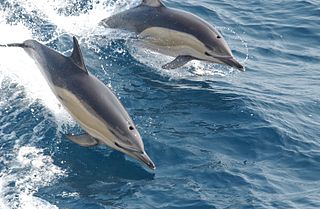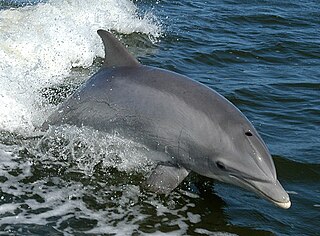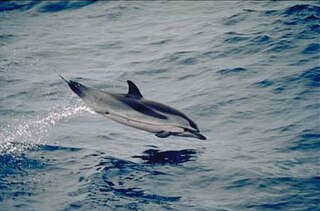
A dolphin is an aquatic mammal within the infraorder Cetacea. Dolphin species belong to the families Delphinidae, Platanistidae, Iniidae, Pontoporiidae, and possibly extinct Lipotidae. There are 40 extant species named as dolphins.

Blubber is a thick layer of vascularized adipose tissue under the skin of all cetaceans, pinnipeds, penguins, and sirenians. It was present in many marine reptiles, such as ichthyosaurs and plesiosaurs.

Bottlenose dolphins are aquatic mammals in the genus Tursiops. They are common, cosmopolitan members of the family Delphinidae, the family of oceanic dolphins. Molecular studies show the genus contains three species: the common bottlenose dolphin, the Indo-Pacific bottlenose dolphin, and Tamanend's bottlenose dolphin. Others, like the Burrunan dolphin, may be alternately considered their own species or be subspecies of T. aduncus. Bottlenose dolphins inhabit warm and temperate seas worldwide, being found everywhere except for the Arctic and Antarctic Circle regions. Their name derives from the Latin tursio (dolphin) and truncatus for the truncated teeth.

Oceanic dolphins or Delphinidae are a widely distributed family of dolphins that live in the sea. Close to forty extant species are recognised. They include several big species whose common names contain "whale" rather than "dolphin", such as the Globicephalinae. Delphinidae is a family within the superfamily Delphinoidea, which also includes the porpoises (Phocoenidae) and the Monodontidae. River dolphins are relatives of the Delphinoidea.

The common dolphin is the most abundant cetacean in the world, with a global population of about six million. Despite this fact and its vernacular name, the common dolphin is not thought of as the archetypal dolphin, with that distinction belonging to the bottlenose dolphin due to its popular appearances in aquaria and the media. However, the common dolphin is often depicted in Ancient Greek and Roman art and culture, most notably in a mural painted by the Greek Minoan civilization.

The false killer whale is a species of oceanic dolphin that is the only extant representative of the genus Pseudorca. It is found in oceans worldwide but mainly in tropical regions. It was first described in 1846 as a species of porpoise based on a skull, which was revised when the first carcasses were observed in 1861. The name "false killer whale" comes from having a skull similar to the orca, or killer whale.

The Indo-Pacific bottlenose dolphin is a species of bottlenose dolphin. This dolphin grows to 2.6 m (8.5 ft) long, and weighs up to 230 kg (510 lb). It lives in the waters around India, northern Australia, South China, the Red Sea, and the eastern coast of Africa. Its back is dark grey and its belly is lighter grey or nearly white with grey spots.

The Atlantic spotted dolphin is a dolphin found in warm temperate and tropical waters of the Atlantic Ocean. Older members of the species have a very distinctive spotted coloration all over their bodies.

The common bottlenose dolphin or Atlantic bottlenose dolphin is one of three species of bottlenose dolphin in the genus Tursiops. The common bottlenose dolphin is a very familiar dolphin due to the wide exposure it receives in captivity in marine parks and dolphinariums, and in movies and television programs. Spending their entire life in water, common bottlenose dolphins inhabit temperate and tropical oceans throughout the world, absent only from polar waters. While formerly known simply as the bottlenose dolphin, this term is now applied to the genus Tursiops as a whole. As considerable genetic variation has been described within this species, even between neighboring populations, many experts think additional species may be recognized.

The striped dolphin is an extensively researched dolphin found in temperate and tropical waters of all the world's oceans. It is a member of the oceanic dolphin family, Delphinidae.
Louis Herman was an American marine biologist. He was a researcher of dolphin sensory abilities, dolphin cognition, and humpback whales. He was professor in the Department of Psychology and a cooperating faculty member of the Department of Oceanography at the University of Hawaiʻi at Mānoa. He founded the Kewalo Basin Marine Mammal Laboratory (KBMML) in Honolulu, Hawaii in 1970 to study bottlenose dolphin perception, cognition, and communication. In 1975, he pioneered the scientific study of the annual winter migration of humpback whales into Hawaiian waters. Together with Adam Pack, he founded The Dolphin Institute in 1993, a non-profit corporation dedicated to dolphins and whales through education, research, and conservation.

The Tethys Research Institute is a non-profit research organisation founded in 1986 to support marine conservation through science and public awareness and by participating in the international conservation process. Tethys' activities are mainly carried out in the Mediterranean Sea, although research programmes have been conducted also in the Black Sea, the North Atlantic Ocean, the Caribbean, the Red Sea and Antarctica. The results of these activities have been presented in scientific publications as well as in meetings, workshops and conferences.
The Bottlenose Dolphin Research Institute (BDRI) is a research and educational centre dedicated to the understanding and conservation of cetaceans and the marine environment in which they live. The Institute's BDRI center was founded by the biologist Bruno Díaz López in Sardinia, Italy in 2005. In 2014, the BDRI opened a new facility in Galicia, Spain.

The Agreement on the Conservation of Cetaceans of the Black Sea, Mediterranean Sea and contiguous Atlantic Area, or ACCOBAMS, is a regional international treaty that binds its States Parties on the conservation of Cetacea in their territories. The Agreement aims is to reduce threats to Cetaceans in the Mediterranean and Black Seas, as well as in the contiguous Atlantic area west of the Straits of Gibraltar.

East Matagorda Bay is a bay off Matagorda County on the Texas Gulf Coast, enclosed by the Matagorda Peninsula and the tidal flats at the mouth of the Colorado River. It is a minor estuary, one of a series of estuaries along the Gulf Coast of Texas, but it has no significant river sources, receiving only the runoff from the adjacent coastal watershed. Its only true opening to the Gulf of Mexico is through Brown Cedar Cut, near the north end of the peninsula. East Matagorda Bay was devastated by the 1942 Matagorda Hurricane, the most devastating hurricane of the 1942 Atlantic hurricane season.

The Burrunan dolphin is a proposed species of bottlenose dolphin found in parts of Victoria, Australia first described in 2011. Its exact taxonomy is debated: numerous studies support it as being a separate species within the genus Tursiops and occupying a basal position within the genus, with limited phylogenetic studies using different methodologies indicate that it is a subspecies of the Indo-Pacific bottlenose dolphin. The Burrunan dolphin is not currently recognized as a species by the Society for Marine Mammalogy or American Society of Mammalogists, which cites problematic methodology in the original study proposing species status and recommends further research.

The Kazantyp Nature Reserve is a small reserve in the Lenine Raion on the Kerch Peninsula in Crimea. The reserve includes both territory of Cape Kazantyp and coast-aquatic-complex.

A signature whistle is a learned, individually distinctive whistle type in a bottlenose dolphin's acoustic repertoire that gives the identity of the whistle owner. The whistles are identified and studied in the wild or in captivity by researchers using hydrophones. Vocal learning strongly influences the development of signature whistles, which can remain stable for up to at least 12 years. More often than not, calves develop signature whistles by the sounds they hear while making sure that they differ from close associates. However, male calves tend to learn signature whistles that resemble their mother's. They are believed to be most frequently used in the communication of captive bottlenose dolphins, along with having specialized functions and properties. Signature whistles are in a higher frequency range than humans can hear. Researchers define a signature whistle as a whistle with a unique frequency curve that dominates in the repertoire of a dolphin. Each dolphin has a distinct signature whistle that other members of its social group use to individually identify the whistler. They are typically used for localisation purposes, however they also provide dolphins with behavioural context. Signature whistles have an important role in facilitating mother–calf contact, group cohesion and social interaction.
Tamanend's bottlenose dolphin is a species of bottlenose dolphin that inhabits coastal waters in the eastern United States. This species was previously considered a nearshore variant of the common bottlenose dolphin Tursiops truncatus.















